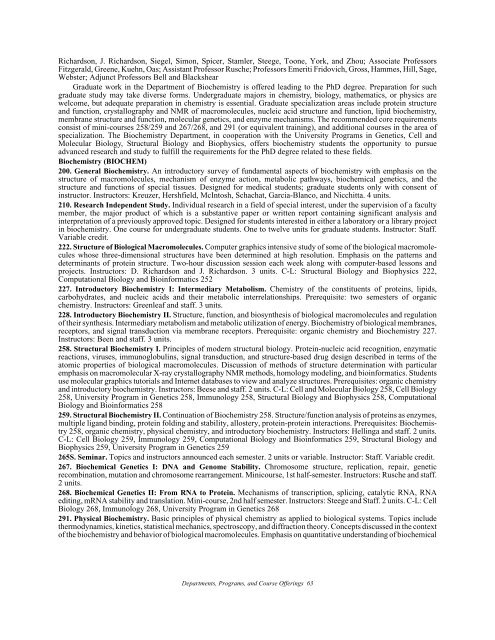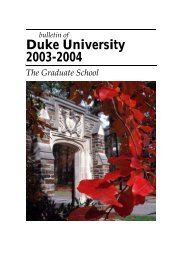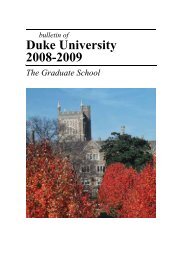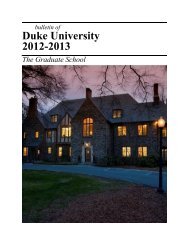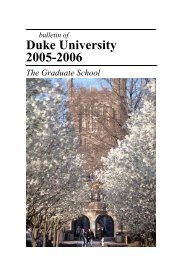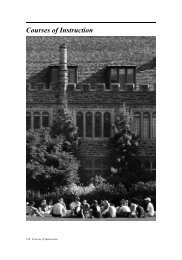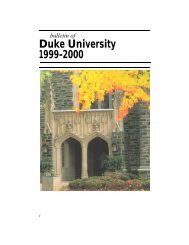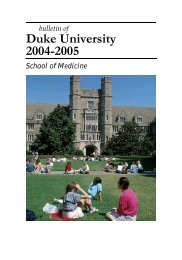Duke University 2009-2010 - Office of the Registrar - Duke University
Duke University 2009-2010 - Office of the Registrar - Duke University
Duke University 2009-2010 - Office of the Registrar - Duke University
Create successful ePaper yourself
Turn your PDF publications into a flip-book with our unique Google optimized e-Paper software.
Richardson, J. Richardson, Siegel, Simon, Spicer, Stamler, Steege, Toone, York, and Zhou; Associate Pr<strong>of</strong>essors<br />
Fitzgerald, Greene, Kuehn, Oas; Assistant Pr<strong>of</strong>essor Rusche; Pr<strong>of</strong>essors Emeriti Fridovich, Gross, Hammes, Hill, Sage,<br />
Webster; Adjunct Pr<strong>of</strong>essors Bell and Blackshear<br />
Graduate work in <strong>the</strong> Department <strong>of</strong> Biochemistry is <strong>of</strong>fered leading to <strong>the</strong> PhD degree. Preparation for such<br />
graduate study may take diverse forms. Undergraduate majors in chemistry, biology, ma<strong>the</strong>matics, or physics are<br />
welcome, but adequate preparation in chemistry is essential. Graduate specialization areas include protein structure<br />
and function, crystallography and NMR <strong>of</strong> macromolecules, nucleic acid structure and function, lipid biochemistry,<br />
membrane structure and function, molecular genetics, and enzyme mechanisms. The recommended core requirements<br />
consist <strong>of</strong> mini-courses 258/259 and 267/268, and 291 (or equivalent training), and additional courses in <strong>the</strong> area <strong>of</strong><br />
specialization. The Biochemistry Department, in cooperation with <strong>the</strong> <strong>University</strong> Programs in Genetics, Cell and<br />
Molecular Biology, Structural Biology and Biophysics, <strong>of</strong>fers biochemistry students <strong>the</strong> opportunity to pursue<br />
advanced research and study to fulfill <strong>the</strong> requirements for <strong>the</strong> PhD degree related to <strong>the</strong>se fields.<br />
Biochemistry (BIOCHEM)<br />
200. General Biochemistry. An introductory survey <strong>of</strong> fundamental aspects <strong>of</strong> biochemistry with emphasis on <strong>the</strong><br />
structure <strong>of</strong> macromolecules, mechanism <strong>of</strong> enzyme action, metabolic pathways, biochemical genetics, and <strong>the</strong><br />
structure and functions <strong>of</strong> special tissues. Designed for medical students; graduate students only with consent <strong>of</strong><br />
instructor. Instructors: Kreuzer, Hershfield, McIntosh, Schachat, Garcia-Blanco, and Nicchitta. 4 units.<br />
210. Research Independent Study. Individual research in a field <strong>of</strong> special interest, under <strong>the</strong> supervision <strong>of</strong> a faculty<br />
member, <strong>the</strong> major product <strong>of</strong> which is a substantive paper or written report containing significant analysis and<br />
interpretation <strong>of</strong> a previously approved topic. Designed for students interested in ei<strong>the</strong>r a laboratory or a library project<br />
in biochemistry. One course for undergraduate students. One to twelve units for graduate students. Instructor: Staff.<br />
Variable credit.<br />
222. Structure <strong>of</strong> Biological Macromolecules. Computer graphics intensive study <strong>of</strong> some <strong>of</strong> <strong>the</strong> biological macromolecules<br />
whose three-dimensional structures have been determined at high resolution. Emphasis on <strong>the</strong> patterns and<br />
determinants <strong>of</strong> protein structure. Two-hour discussion session each week along with computer-based lessons and<br />
projects. Instructors: D. Richardson and J. Richardson. 3 units. C-L: Structural Biology and Biophysics 222,<br />
Computational Biology and Bioinformatics 252<br />
227. Introductory Biochemistry I: Intermediary Metabolism. Chemistry <strong>of</strong> <strong>the</strong> constituents <strong>of</strong> proteins, lipids,<br />
carbohydrates, and nucleic acids and <strong>the</strong>ir metabolic interrelationships. Prerequisite: two semesters <strong>of</strong> organic<br />
chemistry. Instructors: Greenleaf and staff. 3 units.<br />
228. Introductory Biochemistry II. Structure, function, and biosyn<strong>the</strong>sis <strong>of</strong> biological macromolecules and regulation<br />
<strong>of</strong> <strong>the</strong>ir syn<strong>the</strong>sis. Intermediary metabolism and metabolic utilization <strong>of</strong> energy. Biochemistry <strong>of</strong> biological membranes,<br />
receptors, and signal transduction via membrane receptors. Prerequisite: organic chemistry and Biochemistry 227.<br />
Instructors: Been and staff. 3 units.<br />
258. Structural Biochemistry I. Principles <strong>of</strong> modern structural biology. Protein-nucleic acid recognition, enzymatic<br />
reactions, viruses, immunoglobulins, signal transduction, and structure-based drug design described in terms <strong>of</strong> <strong>the</strong><br />
atomic properties <strong>of</strong> biological macromolecules. Discussion <strong>of</strong> methods <strong>of</strong> structure determination with particular<br />
emphasis on macromolecular X-ray crystallography NMR methods, homology modeling, and bioinformatics. Students<br />
use molecular graphics tutorials and Internet databases to view and analyze structures. Prerequisites: organic chemistry<br />
and introductory biochemistry. Instructors: Beese and staff. 2 units. C-L: Cell and Molecular Biology 258, Cell Biology<br />
258, <strong>University</strong> Program in Genetics 258, Immunology 258, Structural Biology and Biophysics 258, Computational<br />
Biology and Bioinformatics 258<br />
259. Structural Biochemistry II. Continuation <strong>of</strong> Biochemistry 258. Structure/function analysis <strong>of</strong> proteins as enzymes,<br />
multiple ligand binding, protein folding and stability, allostery, protein-protein interactions. Prerequisites: Biochemistry<br />
258, organic chemistry, physical chemistry, and introductory biochemistry. Instructors: Hellinga and staff. 2 units.<br />
C-L: Cell Biology 259, Immunology 259, Computational Biology and Bioinformatics 259, Structural Biology and<br />
Biophysics 259, <strong>University</strong> Program in Genetics 259<br />
265S. Seminar. Topics and instructors announced each semester. 2 units or variable. Instructor: Staff. Variable credit.<br />
267. Biochemical Genetics I: DNA and Genome Stability. Chromosome structure, replication, repair, genetic<br />
recombination, mutation and chromosome rearrangement. Minicourse, 1st half-semester. Instructors: Rusche and staff.<br />
2 units.<br />
268. Biochemical Genetics II: From RNA to Protein. Mechanisms <strong>of</strong> transcription, splicing, catalytic RNA, RNA<br />
editing, mRNA stability and translation. Mini-course, 2nd half semester. Instructors: Steege and Staff. 2 units. C-L: Cell<br />
Biology 268, Immunology 268, <strong>University</strong> Program in Genetics 268<br />
291. Physical Biochemistry. Basic principles <strong>of</strong> physical chemistry as applied to biological systems. Topics include<br />
<strong>the</strong>rmodynamics, kinetics, statistical mechanics, spectroscopy, and diffraction <strong>the</strong>ory. Concepts discussed in <strong>the</strong> context<br />
<strong>of</strong> <strong>the</strong> biochemistry and behavior <strong>of</strong> biological macromolecules. Emphasis on quantitative understanding <strong>of</strong> biochemical<br />
Departments, Programs, and Course Offerings 63


